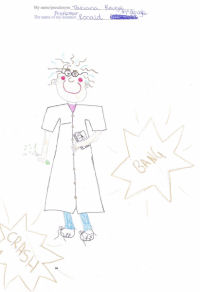
The (In)visible Witnesses Project
Investigating gendered
representations of scientists, technologists, engineers and mathematicians
on UK television
| Introduction |
| Project Outline |
| Further Work |
| Project Dissemination |
| Project Team |
| Contact Us |
| Last Updated July 23, 2013 |
Project outline
 In the first phase of the project we conducted an analysis of
content to investigate images of STEM in two one-week samples (October
2005 and March 2006) of UK television output for the five channels broadcasting
using analogue (and digital) signals: BBC1, BBC2, ITV1, Channel 4 and Channel
5. Initially, we quantified
how much STEM appeared on UK television at these times. We then analysed
a range of programme genres (e.g. ranging from news and current affairs
to cartoons and animations) aimed at children and young people. This analysis focused on representations of the nature and value of STEM; the ways in which the identities of the STEM-related characters are constructed; and, the relationships between STEM-related and other characters from a gender perspective.
In the first phase of the project we conducted an analysis of
content to investigate images of STEM in two one-week samples (October
2005 and March 2006) of UK television output for the five channels broadcasting
using analogue (and digital) signals: BBC1, BBC2, ITV1, Channel 4 and Channel
5. Initially, we quantified
how much STEM appeared on UK television at these times. We then analysed
a range of programme genres (e.g. ranging from news and current affairs
to cartoons and animations) aimed at children and young people. This analysis focused on representations of the nature and value of STEM; the ways in which the identities of the STEM-related characters are constructed; and, the relationships between STEM-related and other characters from a gender perspective.
In the second phase of the project we worked with two class-sized groups of children and young people (aged 8 – 15) to explore how children and young people interpret and contextualise images of STEM on UK television. Each group took part in a series of activities that included completing a questionnaire; the ‘Draw-A-Scientist’ test; identifying and discussing STEM and STEM-related characters in TV programmes; creating ideas for programmes that would encourage children and young people to engage with STEM; and writing about what it might be like to work in STEM.
-
A detailed discussion of these two phases of the project can be found in the initial project report.
-
A summary of the report, including key recommendations, can be found in the research briefing.
-
An article about the project first appeared in Open Eye on 6 May 2008. Open Eye is the bulletin of the Open University community, published in the Independent newspaper on the first Tuesday of each month.
In Phase 3 of the project we extended the content analysis element of the project to focus on three television series that were identified by the children and young people as being either their favourite television programmes or as being about science or including a scientist. These series were The Simpsons (Channel 4), Doctor Who (BBC) and Brainiac Science Abuse (Sky TV). We also extended our work with the children and young people themselves.
A key premise that has underpinned all of the audience reception studies carried out as part of the (In)visible Witnesses project is that children and young people are not simply passive receivers of media messages, but active viewers and interpreters of media representations. Indeed, we have argued that this process of interpretation plays an important role in the ways in which children and young people actively construct their sense of self-concept and their identities. The methods used within the studies, therefore, have been designed to engage with, and capitalise on, the participants’ media literacy skills. For Phase 3 of the project the participants carried out a series of activities designed to support them in analysing short extracts from the programmes we examined in our content analysis and to engage with the ‘creative’ element of their media literacy skills by planning a STEM-related television series and then ‘pitching’ their ideas to an (imagined) Executive Board of a television production company, which was looking to commission STEM-related programming.
-
A detailed discussion of Phase 3 of the project can be found in the second project report.